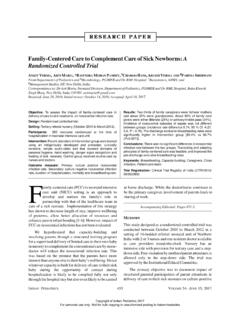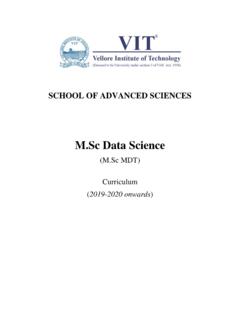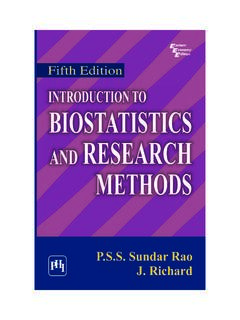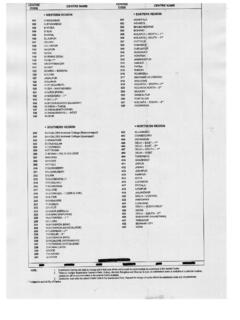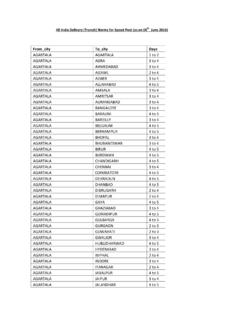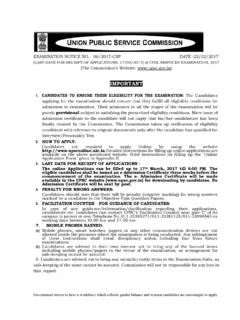Transcription of Current Perspective on Exchange Transfusion - Indian …
1 Reminiscences from Indian Pediatrics: A Tale of 50 Years Current Perspective on Exchange Transfusion DIPTI KAPOOR, PREETI SINGH AND *ANJU SETH. Department of Pediatrics, Lady Hardinge Medical College, New Delhi, India. N. eonatal hyperbilirubinemia (NNH) continues strict surgical asepsis, the use of transparent catheter to be an important cause of hospital (polyvinyl feeding tube with a rounded end and side holes). admission in the early neonatal for umbilical catheterization was strongly suggested, as it period. The November 1967 issue of Indian enabled easy identification of the air bubbles that can cause Pediatrics had an article on experience with Exchange of air embolism if pushed into the circulation. The Transfusion in the neonates. Through this communication, clearance of blocked catheters (clots in the circulation). we present the advances and the Current Perspective on using pressure was strongly reprehended. In situations Exchange Transfusion in the management of neonatal where the high venous pressure was recorded or in the hyperbilirubinemia.
2 Presence of heart failure, a deficit Exchange was carried until the pressure THE PAST normalized. The author felt that with the above discipline, the risk of The study by Mammen KC [1], complications due to ET can be published in November 1967 issue of significantly reduced. Indian Pediatrics, is a retrospective review of records of 27 Exchange Historical background and past transfusions (ET) done on 21 infants knowledge: The use of ET (also known admitted in Christian Medical as exsanguination, venesection, or college, vellore from 1964-1965. Of substitution Transfusion ) was foremost 3686 live-births, non-hemolytic reported by Dr AP Hart in 1925 in a hyperbilirubinemia was reported in 30 severely jaundiced neonate with mature and 35 premature infants while erythroblastosis fetalis. He used the 24 neonates had hemolytic disease sagittal sinus for removing blood while (11 Rh incompatibility, 13 ABO infusing it through a peripheral venous incompatibility).
3 The ET was performed cut-down. Louis Diamond [2] was the in 4 of 30 mature and 4 of 35 immature pioneer to utilize the umbilical vein for neonates with non-hemolytic hyperbilirubinemia. Among ET in 1946. He provided the complete technique and 24 cases with hemolytic disease of newborn, ET was apparatus required for performing ET. In 1963, AW Liley performed in 9 of 11 cases with Rh incompatibility and 4 of introduced the technique of intrauterine and intraperitoneal 13 cases with ABO incompatibility. There were 3 deaths transfusions in the management of severe anemia and NNH. reported (1 established kernicterus, 1 pneumonia, 1 heart in fetuses during mid-gestation based on the failure in hydrops) but none died due to the procedure itself. spectrophotometric assessment of the bilirubinoid pigment in the amniotic fluid. J rg Schneider was the first The author highlighted a few practical points in the investigator to accomplish rhesus prophylaxis in pregnant technique of ET.
4 He emphasized the use of O-negative women in 1963. Over the following years, the role of ante- blood (partially packed RBC), 80 cc/pound, cross-matched partum and post-partum rhesus prophylaxis has been with mother's blood for ET, unless both the mother-baby established that has significantly decreased the fetal duo had the same ABO group. Strict monitoring was morbidity and mortality. recommended during the procedure keeping a tally of the aliquots and the cycles exchanged. To prevent THE PRESENT. hypocalcemia, 1 mL of 10% calcium gluconate was infused There has been a steady fall in the incidence of severe after every 100 mL of citrated blood exchanged. Besides NNH requiring ET in the Current era; however, the risk of Indian PEDIATRICS 961 VOLUME 54__NOVEMBER 15, 2017. A TALE OF 50 YEARS. developing acute bilirubin encephalopathy and to the one described by Diamond. Nowadays, we use the permanent neurological sequelae still remains [3].
5 ET is disposable ET tray that includes all the necessary an effective emergency intervention to lower the bilirubin instruments, catheters, syringes, four-way valve, pipe levels in infants at high risk of bilirubin encephalopathy. lines extension, bag of blood waste, with additional The indications of ET in infants 35 weeks gestation are facility for warming the donor blood in some centers. To as per the AAP guidelines published in 2004, while in overcome the drawbacks of push-pull technique, preterms and low birth weight neonates, the need for ET Continuous Arterio-Venous Exchange (CAVE) has been is determined by the birth weight, gestational age and the proposed as an alternative [8]. The attempts to automate severity of clinical sickness [4]. The outcome of ET is the ET technique have failed due to technical difficulties. dependent on many factors, including the indication and REFERENCES. timing of the procedure. A modified bilirubin-induced neurologic dysfunction (BIND-M) score has been 1.
6 Mammen KC. Experience with Exchange transfusions in the formulated to identify the neonates with severe acute neonates. Indian ;4:413-7. bilirubin encephalopathy requiring immediate ET to limit 2. Diamond LK, Allen FH Jr, Thomas WO Jr. Erythroblastosis or reverse adverse neurodevelopmental outcomes [5,6]. fetalis. VII. Treatment with Exchange Transfusion . N Engl J. Med. 1951;244:39-44. Over the past few decades, development and 3. Slusher TM, Olusanya BO. Neonatal jaundice in low- and widespread use of rhesus immunoglobulin, intra-uterine middle-income countries. In: Stevenson DK, Maisels J, Transfusion , improvement in diagnostic prenatal Watchko J, editors. Care of the Jaundiced Neonate. New York:McGraw-Hill; 2012. p. 263-73. ultrasound intensive phototherapy and intravenous 4. American Academy of Pediatrics Subcommittee on immunoglobulin, has resulted in progressive reduction Hyperbilirubinemia. Management of hyperbilirubinemia in for the need of ET.
7 Antenatal serial measurement of anti- the newborn infant 35 or more weeks of gestation. D antibody levels, assessment of middle cerebral artery Pediatrics. 2004;114:297-316. peak systolic velocity (MCA-PSV) and serial 5. Radmacher PG, Groves FD, Owa JA, Ofovwe GE, amniocentesis for delta OD450 can predict the risk of Amaubunos EA, Olusanya BO, et al. A modified Bilirubin- severe hemolytic disease and the need of ET in a neonate. induced neurologic dysfunction (BIND-M) algorithm is useful in evaluating severity of jaundice in a resource- The etiology of hyperbilirubinemia requiring ET in limited setting. BMC Pediatr. 2015;15:28. Current times is different from 1900s when severe Rh 6. Olusanya BO, Osibanjo FB, Ajiboye AA, Ayodele OE, isoimmunization was predominant. The most common Odunsi AA, Olaifa SM, et al. A neurologic dysfunction indication for neonatal Exchange Transfusion currently is scoring protocol for jaundiced neonates requiring Exchange hemolytic disease of the newborn due to maternal Transfusion .
8 J Matern Fetal Neonatal Med. 2017;20:1-7. isoimmunization to blood groups other than Rh D. 7. Pugni L, Ronchi A, Bizzarri B, Consonni D, Pietrasanta C, Ghirardi B, et al. Exchange Transfusion in the treatment of Besides hyperbilirubinemia, use of ET has been extended neonatal septic shock: A ten-year experience in a neonatal in the management of conditions like nonimmune intensive care unit. Int J Mol Sci. 2016;17(5): hydrops fetalis, congenital leukemia, disseminated ijms17050695. intravascular coagulation, sclerema neonatorum, 8. Shah R, Kumar P. Continuous Arteriovenous Exchange hyperammonemia, polycythemia, fluid and electrolyte (CAVE): A new technique of partial Exchange Transfusion imbalance, and severe neonatal sepsis [7]. In: Nangia S, Sharma M (eds). Proceedings of the XXIX. Annual Convention of National Neonatology Forum. The method, equipment and precautions of the ET 10 13 December; Poster Innovation/2: Ahmedabad, India, have largely remained the same over the years, identical 2009, p.
9 122. Indian PEDIATRICS 962 VOLUME 54__NOVEMBER 15, 2017.


